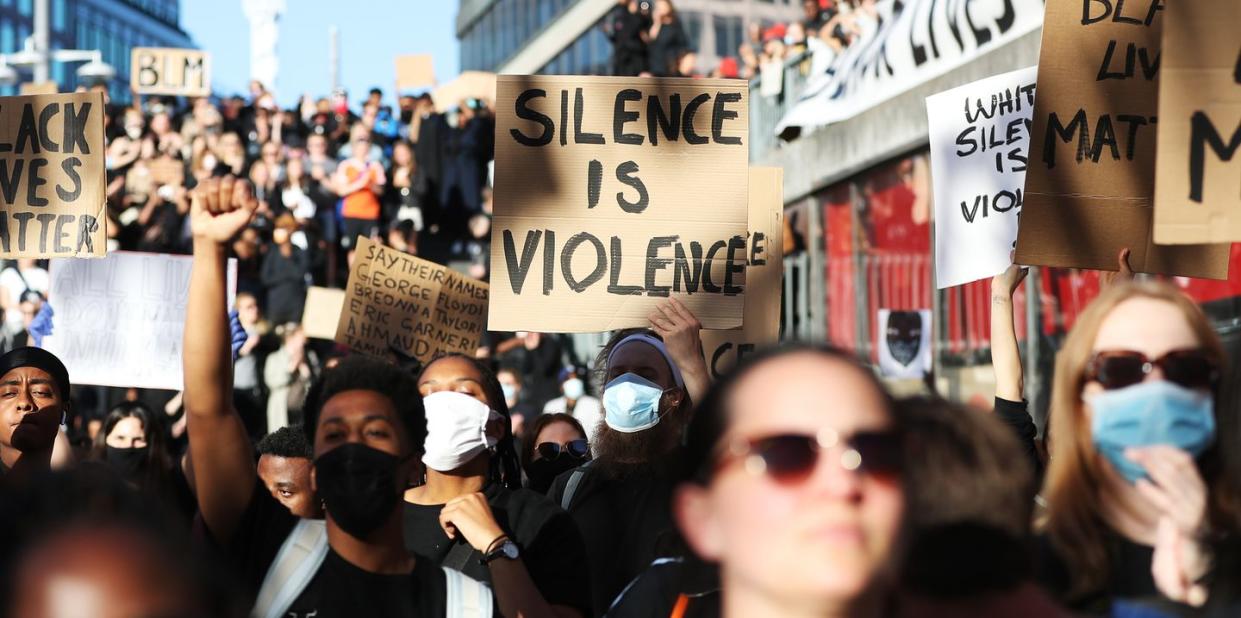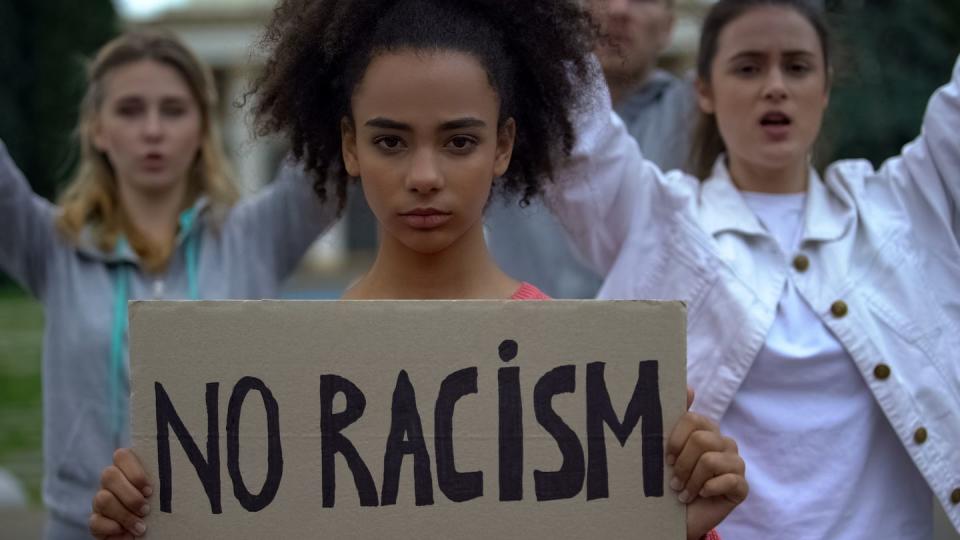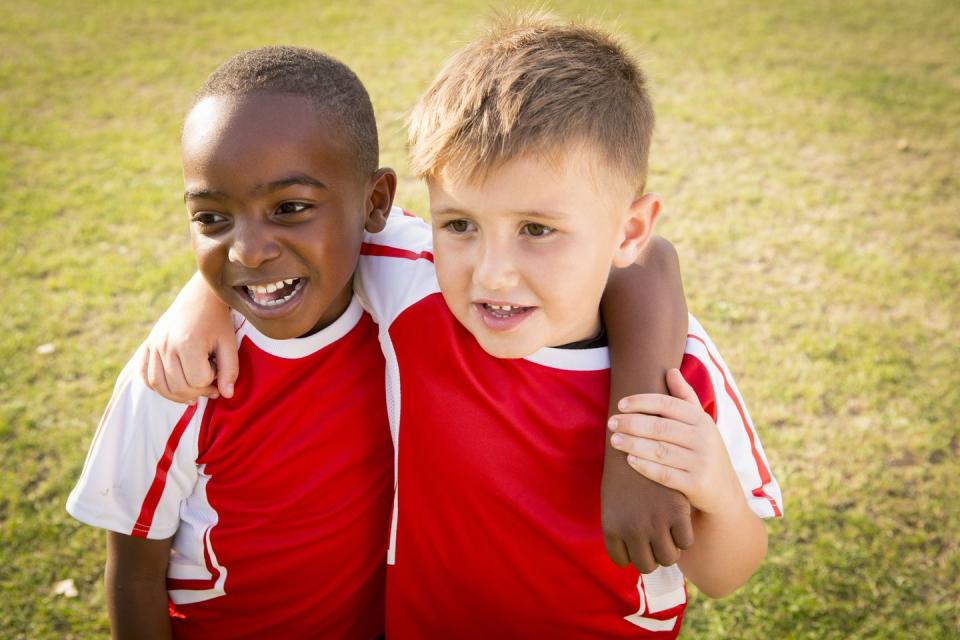How to Talk to Your Kids About Racism In a Way They'll Understand

As people around the country protest against police brutality and systemic racism, parents — particularly white parents — are tasked with facilitating tough, but necessary conversations with their children. Learning how to talk to your kids about racism is a vital step in eradicating the systemic inequalities that have resulted in the oppression of Black people and people of color, and ensuring a more just and safe future for Black people and their families.
Currently, being shot by a police officer is a leading cause of death for young Black men in America. Black women are three to four times more likely to die from pregnancy-related complications than white women, Black people only hold 3.2 percent of executive jobs in the United States, and are incarcerated at more than five times the rate of white people.
Although it's natural to feel a need to shield children from hate, bias, and discrimination in order to protect their innocence and preserve their childhood, not every parent has that option. For Black mothers and fathers, and other parents of color, this reality is something they cannot ignore, wish away, or escape from — they live it every single day. And these difficult conversations can often mean the difference between life and death.
It's OK if you don't have all the answers or don't know what to say. It's OK if you're afraid of saying the wrong thing or "messing up." But parenthood is all about doing your best, facing challenges head on, learning from your mistakes, then adjusting accordingly. These ongoing conversations can serve as a catalyst for necessary change, can better equip those in positions of privilege to uplift and protect communities of color, and can help build a more equitable future for all children.
As yourself some questions before talking to your child.
"I think that, if you’re not Black, you do have to ask yourself a lot of questions to determine the extent of your own racism," Susan Abbott, M.D., a child and adolescent psychiatrist practicing in New York City, tells Woman's Day. "Examine your own upbringing. Examine what you heard growing up. Examine what you assumed growing up." This can be a difficult exercise, Abbott says, and it can be painful. But, according to Abbott, it is necessary and an important first-step in parents facilitating these necessary conversations with their children.
The 2015 review of implicit bias, published by the Kirwan Institute, is a great tool to better understanding the biases present in every person, and how they can result in the continued oppression of Black people and other people of color
Meet your child where they are developmentally.
Obviously, you wouldn't discuss racism with a pre-schooler in the same way you would discuss racism with a high school senior. Before discussing racism, race, and other aspects of inequality, make sure you meet your child where they are developmentally and approach the conversation in a way that they will understand.

"It is important to have a developmental perspective," Abbott says. "Kids can only understand so much at a given age." For children who are in pre-school, Abbott says they think in concrete terms. For example, right versus wrong. They also rely heavily on what and how you think.
"They want to judge, they want to rank what's 'better,' they want to try to figure out what you really think is 'better,' even if you're not saying it," Abbott explains. "So I think parents need to, right away, equalize the beauty of all colors. And I think you can start right then and there with a young child."
As your child gets older, Abbott says they begin to think of things in terms of "rules." "They might ask, 'What are the rules? Is everyone going by the rules?' And you can answer them in that sense," she says. "And when they get even older, in middle school, they understand more about morality and ethics. And that's when you can get into more in-depth discussions about rights and how racism takes away people's rights. And you can tie that together with history. History shows us how racism takes away people's rights."
Let your child lead the conversation.
Instead of preaching to your child, Abbott suggests you give them the room and space to speak first. "I also think it’s important that you ask your kids questions," she says. "What have they heard? What are they thinking about? What are they wondering about? This is how you can really find out what is on their mind."
Racism and the implications of racism, especially when it permeates every facet of society, is traumatic. And during traumatic events, Abbott explains, it's helpful to allow your child to lead the conversation so you can better understand what they require from you. "I think most of the time when you're talking about traumatic events, you do want the kids to take the lead," she says. "Because you don’t know what their fears are and you don’t know what their assumptions are. You don’t know whose thoughts and opinions they might be mimicking or acquiring."
Armed with the knowledge of what they want and need to know, what they've already heard, and what concerns them, you can approach the conversation in a more productive way.
Learn the history of racism in this country, then rely on it.
The United State's history is riddled with examples of racism and the generational damage it causes. Abbott says you can use these examples in age-appropriate ways to not only talk to children about what racism is, but to explain to them how important it is to eradicate it from our society.

"If a child says 'What is racism?', history is bleak with examples," Abbott explains. "And a lot of white kids don't know the history. And those of us who’re white and privileged are learning the history, too. And so I think that educating ourselves about Black history and about these events — I think that is where parents are going to be able to explain racism."
The white-washing of American history has long been documented, but there are a number of online resources that give accurate accounts of racism, how this country was founded on it, and how it has remained as this country has evolved. A good place to start is Facinghistory.org, The Knotted Line, The 1619 Project, and the History Channel's timeline of Black history milestones.
Utilize books, podcasts, and other online resources.
"There are a lot more resources now for parents," Abbott says. "Look for books and periodicals that can break things down according to age, because it’s different at different developmental levels."
Embrace Race offers a list of children's books that discuss race and racism. This is a great place to start when looking for materials that can help you talk about racism with your child, regardless of their age.
Keep the conversation going.
Talking about race and racism with your child should not be an isolated incident. Continuing the conversation throughout their lives and as they grow and are better equipped to understand the issues Black and brown people are facing is vital.
"I think the time has come and I think that it is past time to address [racism] with your children, regardless of whether they're exposed to it outright or not," Abbott says. "I think it needs to be part of their ongoing education."
You Might Also Like
